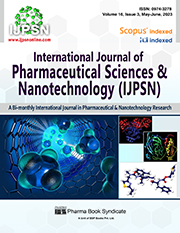Formulation Development and Characterization of Vancomycin Hydrochloride Colon-Targeted Tablets Using In-Situ Polyelectrolyte Complexation Technique
DOI:
https://doi.org/10.37285/ijpsn.2023.16.3.7Abstract
Introduction: Vancomycin hydrochloride (VH) is an amphoteric glycopeptide antibiotic used to manage enterocolitis and pseudomembranous colitis. However, VH is prone to proteolytic degradation in the stomach, thus obscuring the drug entry into the colon. Colon-targeted drug delivery can prevent gastric degradation and localise the drug in the colon.
Methodology: The applicability of in situ polyelectrolyte complexation technique using the polymers Chitosan, Karaya gum, and Hupu gum at various concentrations along with enteric coating using Eudragit S100 was studied for the preparation of colon-targeted tablets of VH.
Colon-targeted tablets of VH are developed by incorporating natural polymers like chitosan, karaya gum, and hupu gum at different concentrations such that in-situ polyelectrolyte complex is formed and the formulations were then coated with Eudragit S100(6%, 8%, and 10% weight gain) to release the drug in a controlled manner in the colon.
Results: Prepared formulations were subjected to in vitro, ex vivo, and in vivo evaluation studies. Out of all the prepared formulations, the formulation H2C10 prepared with 10:2 PEC and 10% Eudragit S100 coating has shown a sufficient lag time of 2 hours in 0.1N HCl, 3 hours of lag time in pH 6.8 phosphate buffer and has shown a 100.02% drug release at 22 hours in pH 7.4 phosphate buffer.
Conclusion: The research results suggested that a colon-targeted drug delivery system of VH can decrease drug degradation and achieve higher concentrations in the colon to provide more therapeutic benefits.
Downloads
Metrics
Keywords:
Colon targeted drug delivery, Chitosan, Hupu gum, In-situ polyelectrolyte complex, In-vivo studies, Karaya gum, Rat cecumDownloads
Published
How to Cite
Issue
Section
References
Korsmeyer RW, Gurny R, Doelker E, Buri P, Peppas NA. Mechanisms of solute release from porous hydrophilic polymers. International journal of pharmaceutics. 1983;15(1):25-35.
Mark HF, Kroschwitz JI. Encyclopedia of Polymer Science and Engineering.; 1985.
Jain SK, Jain A, Gupta Y, Ahirwar M. Design and development of hydrogel beads for targeted drug delivery to the colon. Aaps Pharmscitech. 2007;8(3):E34-E41.
Bigucci F, Luppi B, Cerchiara T, et al. Chitosan/pectin polyelectrolyte complexes: Selection of suitable preparative conditions for colon-specific delivery of vancomycin. European journal of pharmaceutical sciences. 2008; 35(5): 435-441.
Bruniera FR, Ferreira FM, Saviolli LR, et al. The use of vancomycin with its therapeutic and adverse effects: a review. Eur Rev Med Pharmacol Sci. 2015;19(4):694-700.
Geever LM, Cooney CC, Lyons JG, et al. Characterisation and controlled drug release from novel drug-loaded hydrogels. European journal of Pharmaceutics and Biopharmaceutics. 2008; 69(3): 1147-1159.
Tariq MH, Naureen H, Abbas N, Akhlaq M. Development and validation of a method for the analysis of vancomycin in human serum using ultracentrifuge protein precipitation and UV spectroscopy. Lat Am J Pharm. 2015;34(8):1489-1496.
Nirmala K, Raju RR. DETERMINATION OF VANCOMYCIN BY USING RP-HPLC METHOD IN PHARMACEUTICAL PREPARATIONS. Inter-national Journal of Research in Ayurveda & Pharmacy. 2013;4(1).
Almeida AM de, Castel-Branco MM, Falcao AC. Linear regression for calibration lines revisited: weighting schemes for bioanalytical methods. Journal of Chromatography B. 2002; 774(2): 215-222.
Chadha R, Bhandari S. Drug–excipient compatibility screening—role of thermoanalytical and spectroscopic techniques. Journal of pharmaceutical and biomedical analysis. 2014; 87: 82-97.
Lankalapalli S, Kolapalli RM. Biopharmaceutical evaluation of diclofenac sodium controlled release tablets prepared from gum karaya- chitosan polyelectrolyte complexes. Drug Development and Industrial Pharmacy. 2012;38(7):815-824.
Simsek-Ege FA, Bond GM, Stringer J. Polyelectrolyte complex formation between alginate and chitosan as a function of pH. Journal of Applied Polymer Science. 2003;88(2):346-351.
Bandelin FJ. Compressed tablets by wet granulation. Pharmaceutical dosage forms: tablets. 1989; 1:131-193.
Pharmacopoeia I. Vol 2/3. The Indian Pharma-copoeia Commission, Ghaziabad. Published online 2014.
Rao YM, Jithan AV. Advances in Drug Delivery: Volume III. BSP Books Pvt. Limited; 2014.
Commission IP. Indian Pharmacopoeia, 2018. Indian Pharmacopoeia Commission; 2018. https://books.google.co.in/books?id=e6RHswEACAAJ
Report to the office of generic drugs. Vancomycin Dissolution study. Published online February 5, 2008. Accessed May 29, 2012. http://www.fda.gov/ downloads/Advisory Committees/ Committees Meeting Materials/Drugs/Advisory Committee for Pharmaceutical Science and clinical pharma-cology/UCM172604.pdf
Peppas NA. Analysis of Fickian and non-Fickian drug release from polymers. Pharmaceutica Acta Helvetiae. 1985;60(4):110-111.
Krishnaiah YSR, Reddy PB, Satyanarayana V, Karthikeyan RS. Studies on the development of oral colon targeted drug delivery systems for metronidazole in the treatment of amoebiasis. International journal of pharmaceutics. 2002; 236(1-2):43-55.
Reddy RA, Ramesh B, Kishan V. Drug-Excipient Interaction during Formulation Development, in vitro and in vivo Evaluation of Gastroretentive Drug Delivery System for Nizatidine.
Mehta R, Chawla A, Sharma P, Pawar P. Formulation and in vitro evaluation of Eudragit S-100 coated naproxen matrix tablets for colon-targeted drug delivery system. Journal of advanced pharmaceutical technology & research. 2013; 4(1):31.
Abu-Shandi KH. Determination of vancomycin in human plasma using high-performance liquid chromatography with fluorescence detection. Analytical and bioanalytical chemistry. 2009; 395(2): 527-532.
Geldart D, Abdullah EC, Hassanpour A, Nwoke LC, Wouters I. Characterization of powder flowability using measurement of Angle of repose. China Particuology. 2006;4(3-4):104-107.
Ibekwe VC, Fadda HM, Parsons GE, Basit AW. A comparative in vitro assessment of the drug release performance of pH-responsive polymers for ileo-colonic delivery. International Journal of Pharmaceutics. 2006;308(1-2):52-60.
Rubinstein A. Microbially controlled drug delivery to the colon. Biopharmaceutics & drug disposition. 1990;11(6):465-475.
Kinget R, Kalala W, Vervoort L, Van den Mooter G. Colonic drug targeting. Journal of drug targeting. 1998;6(2):129-149.
Wagner JG. Interpretation of percent dissolved-time plots derived from in vitro testing of conventional tablets and capsules. Journal of pharmaceutical sciences. 1969;58(10):1253-1257.






